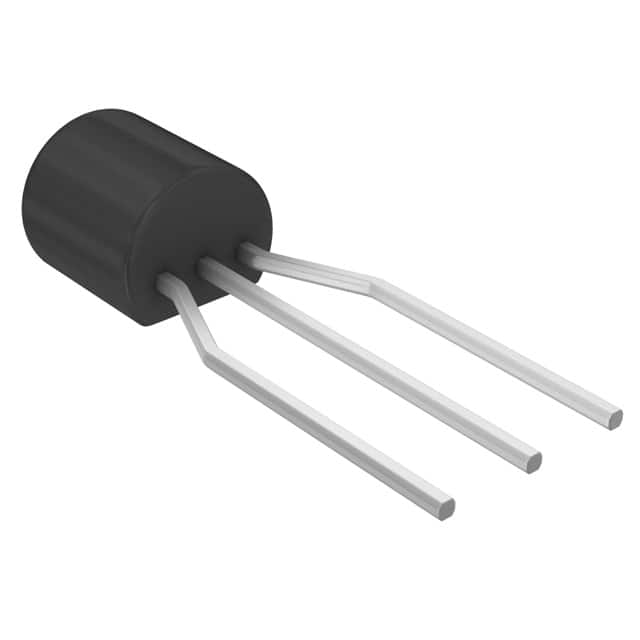BC327RL1
Product Overview
Category
The BC327RL1 belongs to the category of PNP transistors.
Use
It is commonly used as a general-purpose amplifier or switch in electronic circuits.
Characteristics
- Low power dissipation
- High current gain
- Low noise
Package
The BC327RL1 is typically available in a TO-92 package.
Essence
This transistor is essential for amplifying and switching signals in various electronic applications.
Packaging/Quantity
It is usually packaged in reels or tubes, with quantities varying based on manufacturer specifications.
Specifications
- Collector-Emitter Voltage (VCEO): 45V
- Collector-Base Voltage (VCBO): 50V
- Emitter-Base Voltage (VEBO): 5V
- Collector Current (IC): 800mA
- Power Dissipation (PD): 625mW
- Transition Frequency (fT): 100MHz
Detailed Pin Configuration
The BC327RL1 has three pins: collector (C), base (B), and emitter (E). The pin configuration is as follows: - Collector (C) - Pin 1 - Base (B) - Pin 2 - Emitter (E) - Pin 3
Functional Features
- High current gain
- Low saturation voltage
- Good linearity in amplification
Advantages
- Versatile use in amplification and switching applications
- Low power dissipation
- Reliable performance in low-noise circuits
Disadvantages
- Limited maximum current handling capability compared to some other transistors
- Sensitive to temperature variations
Working Principles
The BC327RL1 operates based on the principles of bipolar junction transistors, where the flow of current between the collector and emitter is controlled by the base current.
Detailed Application Field Plans
The BC327RL1 finds extensive use in the following applications: - Audio amplifiers - Signal amplification in sensor circuits - Switching circuits in electronic devices
Detailed and Complete Alternative Models
Some alternative models to the BC327RL1 include: - BC557B - 2N3906 - 2N4403 - BC558B
In conclusion, the BC327RL1 PNP transistor offers reliable performance in amplification and switching applications, making it a versatile component in electronic circuits. Its low power dissipation and high current gain make it suitable for various low-noise applications, although its maximum current handling capability may be a limiting factor in certain high-power scenarios. Understanding its specifications, pin configuration, functional features, and alternative models provides a comprehensive overview of this essential electronic component.
Senaraikan 10 soalan dan jawapan biasa yang berkaitan dengan aplikasi BC327RL1 dalam penyelesaian teknikal
What is the BC327RL1 transistor used for?
- The BC327RL1 is commonly used as a general-purpose PNP bipolar junction transistor (BJT) in various electronic circuits.
What are the typical applications of BC327RL1?
- It is often used in audio amplification, switching, and voltage regulation circuits due to its low noise and high current gain characteristics.
What is the maximum collector current rating of BC327RL1?
- The maximum collector current (Ic) rating for BC327RL1 is typically around 800mA.
What is the maximum collector-emitter voltage rating of BC327RL1?
- The maximum collector-emitter voltage (Vce) rating for BC327RL1 is typically around 45V.
Can BC327RL1 be used for low-power audio amplification?
- Yes, BC327RL1 is suitable for low-power audio amplification applications due to its low noise and high gain properties.
Is BC327RL1 suitable for switching applications?
- Yes, BC327RL1 can be used for low-power switching applications, such as turning on/off small loads in electronic circuits.
What are the key differences between BC327RL1 and other similar transistors?
- BC327RL1 offers low noise and high current gain, making it suitable for audio applications compared to other transistors with different characteristics.
What are the recommended operating conditions for BC327RL1?
- It is recommended to operate BC327RL1 within the specified temperature range and under the maximum ratings for current and voltage.
Can BC327RL1 be used in voltage regulator circuits?
- Yes, BC327RL1 can be utilized in low-power voltage regulator circuits due to its characteristics and performance.
Are there any specific considerations when using BC327RL1 in technical solutions?
- It's important to consider proper biasing, thermal management, and voltage/current limitations when integrating BC327RL1 into technical solutions to ensure reliable operation.
Feel free to ask if you need further details on any of these questions!


